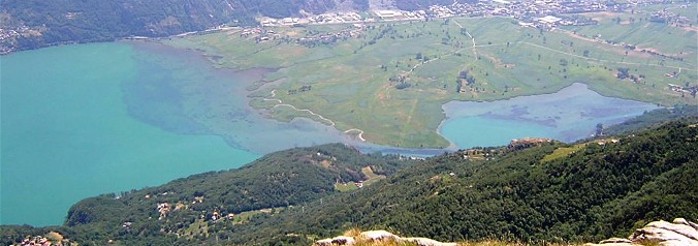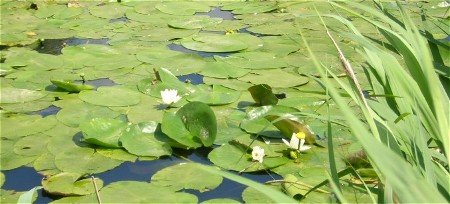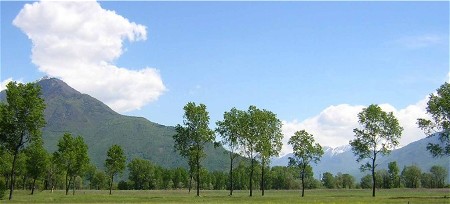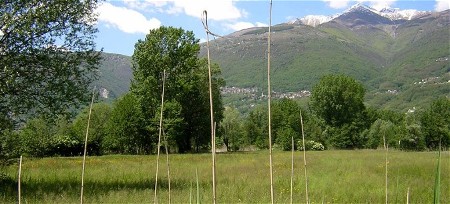
gera lario
home > PIAN DI SPAGNA - imAGES AND DESCRIPTIONS
ITALIANO
il pian di spagna - ImAGES AND DESCRIPTIONS
The territory of the reserve is an alluvial plain made by Adda and Mera, flowing down respectively from Valtellina and Valchiavenna and debouching into Como Lake. The reserve is situated among two natural lakes: Como and Mezzola. In ancient times, these lakes were wider and they pushed as far as Samolaco (which literally means at the top of the lake, from the Latin "Summus Lacus") in Valchiavenna: Adda's floods built the Pian di Spagna and the river was finally canalized in 1858. Como Lake has an important function of thermoregulation of the area: its daily cycle of warming and cooling creates constant breezes ("Breva" in the afternoon and "Tivano" in the morning) which mitigate the rigours of winters and cool summers. Species of birds taking advantage of this favourable climatic and geographic position are numerous and ducks are the most represented: wild ducks, bald-coots, teals, dabchicks, loons and swans are the most common species to be observed, especially during the winter when the vegetation is bare. Seagulls, cormorants and herons are ordinary presences which cannot be unnoticed.
Typical fish of Como Lake are: allis shad (Alosa fallax lacustris), and lake trout (Salmo trutta lacustris), a giant who can reach a meter of length and feeds on other fishes.

The reed thicket is the most typical, but also the most delicate and compromised, natural habitat of the reserve. Ditch reed is a fast growing grass which can reach a man's height and is very common, on the contrary the beautiful reed-mace more and more unusual. (Tipha latifolia). Reeds has always been used by men as covering or straw for domestic animals; they fill the empty spaces among aquatic plants (waterlilies and nenuphars) with their rhizomatous roots preparing the ground for hydrophilous plants such as the willow and for other trees that bring wood where there used to be water. Bladderwort is a underwater carnivorous plant that captures its prays through its bladders. Reclamations, urbanizations and fires threat and reduce the vegetation of ditch reeds, and consequently they menace animal species which nidify and shelter among the reeds: swans (Cygnus olor), bald-coots and wild ducks are among the most common species living there. Among the other birds living in the reed thicket, you can find shovellers, gadwalls, widgeons, dun-birds, pochards, kingfishers, bitterns, reed warblers and great reed warblers.

There are few woods in the reserve and they are mostly situated along the rivers. In the past, they were larger, but they had to give up their extent in favour of fields. Typical trees of the reserve are willows, alders and ash trees. There is a combination of shrubbery (elders, thorns, hawthorns) and trees introduced by men: robinias, poplars, mulberries and birches. Woods on the slopes of the mountains on the borders of the reserve are surely more important: they are mostly chestnut grooves, beech woods and evergreens over a certain height. These woods offer shelter to some species of predaceous birds coming down to the plain in order to prey, but they are also the place where you can find red or green woodpeckers. Mountains are the best place to overlooking the beauties of the reserve, far away from noises and human activities.

Apparently meadows and lawns of the reserve shouldn't be very interesting from a naturalistic point of view, but this is not true: numerous species of wild animals or vegetation live together with men and share with them the cycle of seasons and harvests. More than a half of the territory is pasture field, the remnant are crop fields and other kinds of cultivations. Large sedges are the transitional grasses between reed thickets and cultivated meadows, where the mammalians of the reserve wander about: deers, roes, foxes, wild boars, badgers, beech-martens, weasels, hedgehogs and hares. Otters are to be considered extinct. Among the fields you can see also numerous species of birds: sparrows, hoopoes, crows, skylarks, starlings, robins, tits, cutrettolas, swallows and herons. Among the big size birds are to be reported cranes, storks, buzzards, different kinds of hawks and kites. On the trees and on the high tension cables it is easy to see also owls, tawny owls, owlets and barn owls, looking for their favourite preys: mice, and other little animals such as toads, frogs, lizards, green lizards, salamanders, natrixes, colubers, field mice and shrews.


